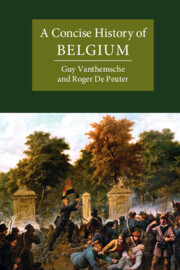Book contents
- A Concise History of Belgium
- Cambridge Concise Histories
- A Concise History of Belgium
- Copyright page
- Dedication
- Contents
- Figures
- Maps
- Acknowledgments
- Note on the Text
- Introduction
- 1 Earliest Times
- 2 The Era of the Frankish Kingdoms
- 3 The Origins of the Medieval Principalities
- 4 Unifying the Netherlands: The Burgundy–Habsburg Period (1384–1555)
- 5 The Spanish Netherlands (1555–1700/1713)
- 6 The Austrian Netherlands (c.1700–1780)
- 7 The Formation of a New Nation-State (1780s–1830)
- 8 The Consolidation of a Bourgeois Regime (1831–1880s)
- 9 The Belgian Nation-State at Its Height (1880s–1945)
- 10 The Metamorphoses of a Nation-State (from 1945 to the Present Day)
- General Conclusion
- Appendix: List of Rulers, Sovereigns and Heads of State (1419–Present) and of Governors General (1507–1794) of the Southern Low Countries and Belgium
- Further Reading
- Index
2 - The Era of the Frankish Kingdoms
(Fifth–Tenth Centuries)
Published online by Cambridge University Press: 16 March 2023
- A Concise History of Belgium
- Cambridge Concise Histories
- A Concise History of Belgium
- Copyright page
- Dedication
- Contents
- Figures
- Maps
- Acknowledgments
- Note on the Text
- Introduction
- 1 Earliest Times
- 2 The Era of the Frankish Kingdoms
- 3 The Origins of the Medieval Principalities
- 4 Unifying the Netherlands: The Burgundy–Habsburg Period (1384–1555)
- 5 The Spanish Netherlands (1555–1700/1713)
- 6 The Austrian Netherlands (c.1700–1780)
- 7 The Formation of a New Nation-State (1780s–1830)
- 8 The Consolidation of a Bourgeois Regime (1831–1880s)
- 9 The Belgian Nation-State at Its Height (1880s–1945)
- 10 The Metamorphoses of a Nation-State (from 1945 to the Present Day)
- General Conclusion
- Appendix: List of Rulers, Sovereigns and Heads of State (1419–Present) and of Governors General (1507–1794) of the Southern Low Countries and Belgium
- Further Reading
- Index
Summary
Almost five hundred years separate the end of Roman rule and the formation of the medieval principalities whose gradual amalgamation would eventually lead, many centuries later, to contemporary Belgium. Traditionally, these so-called Barbarian or Dark Ages have been depicted in harsh contrast with the preceding so-called civilized Roman world. In recent decades, however, medievalists have thoroughly revised this gloomy picture. Rejecting the idea of an abrupt break between Roman and post-Roman times, they now rather observe complex transitions and some measure of continuity between both periods. Important changes undoubtedly took place during the epoch of the Frankish kingdoms. Urban life and monumental stone architecture receded (but did not disappear); artistic expression diverged from the classical canons; Christianity supplanted paganism, etc. But by focusing on spectacular changes such as these, one misses other crucial points: not all Roman institutions vanished suddenly; economic life was not uniformly miserable and trade was far from insignificant; Catholicism did not swiftly replace old creeds and cults; literacy did not disappear and was not limited to clerical elites. Written sources dating from the fifth to the tenth century are certainly far less numerous than those from the later Middle Ages, characterized by an impressive révolution de l’écrit; but for the “Belgian” territories they are unquestionably more abundant than those dating from Roman times. Chronicles, saints’ lives, polyptychs (inventories of goods of large rural domains), charters, diplomas, and even correspondence offer far more than a superficial glimpse of life in the Frankish kingdoms – even if historians have to demonstrate great critical acumen to distinguish forged from authentic records, or to distil reliable “facts” from hagiographies replete with legendary tales. Archaeology also produced startling new insights. Cemeteries, in particular, have yielded a wealth of information: most fifth- to seventh-century objects that we know of today – weapons, jewels, clothing articles, utensils for everyday life, etc. – have been found in graves. New approaches to textual evidence, in combination with material culture studies and (landscape) archaeology have led to a thorough re-evaluation of the Early Middle Ages, a complex period deserving more than worn-out clichés.
- Type
- Chapter
- Information
- A Concise History of Belgium , pp. 43 - 72Publisher: Cambridge University PressPrint publication year: 2023

